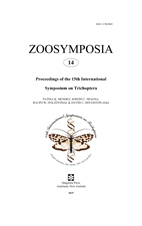Abstract
The first Trichoptera recorded from New Caledonia were four species described by Kimmins in 1953, each in a new endemic genus. The diversity was increased to eight species with the publication by Sykora in 1967 of three new species in two new genera and a fourth species in a previously established genus. Today, 239 valid species are known from the country, representing 20 genera in 10 families. Analysis of published records for some 32,000 Trichoptera specimens collected from 291 localities shows that the highest species diversity is in the SE part of the Grande Terre, and that species diversity is greatest at lower altitudes, i.e. 0–200 meters above sea level. We also see that the three most frequently collected families (85% of the individuals) in the sampled material are Hydroptilidae (35%), followed by Hydropsychidae (27%), and Leptoceridae (22%). Phylogenetic analyses have demonstrated that the first species to occupy the island and the earliest radiations took place on areas covered by ultrabasic substrate, which is poor in nutrients and rich in certain toxic heavy metals.

